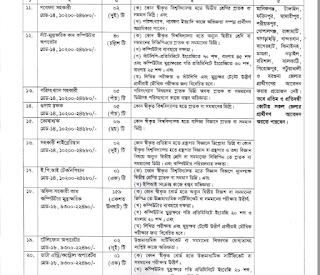Directorate General of Family Planning (DGFP):
Bangladesh is now Asia’s fifth and the world’s eight most populous country with an estimated population of about 162 million. The growth rate of the population has fallen from 3% per annum at the first five year plan (1973-78) to about 1.47% p.a. now. The population is expected to grow by another 40% by mid century, to 222 million, and finally stabilize around 240 million several decades after that.
The Government has recognized that a massive population forms an obstacle to economic development, and has developed the National Population Policy which seeks to reduce fertility to replacement level (RF) by 2015. This requires a further TFR decline of 0.5 children per couple. But even at replacement fertility, the country will be adding two million annually to the population, and many in the population field, feel that the decline needs to be greater, with a target of 1.0 below present fertility (i.e., to TFR 1.7), projected to have substantial benefits across many sectors. It will not fall any lower, so all future population growth will be determined entirely by the fertility level.
High rate of population growth and the resultant increase in population size impede the process of achieving the objectives in various sectors of the economy. Therefore, those ministries and agencies whose target population is affected by population growth would have to share the burden of responsibility of population control and family planning, in addition to the targeted interventions of Ministry of Health and Family Welfare (MOHFW). All these challenges are to be addressed through the interventions of other relevant ministries, in addition to the interventions within MOHFW’s jurisdiction.
The Family Planning (FP) Program implemented by Directorate General of Family Planning (DGFP) has built a nationwide community based FP service delivery system, relying primarily on non-clinical methods such as oral pills and condoms. The emphasis on short- and long-acting clinical methods, which was relatively high in the 1980s, has faded. The current pattern of temporary contraceptive use, with oral pill users close to 30% of all married couples, is reaching saturation (only two other developing countries exceed this proportion), but other individual methods do not even account for 10% each. With persistent early marriage and low fertility, many women have completed their childbearing by the mid-late twenties, leaving them with two decades of reproductive life to avoid unwanted pregnancies. However, the proportions of couples relying on long-acting or permanent FP methods (IUD, implants, male or female sterilization) remains very low (less than 15%). Diversified and mass scale FP services will need to be undertaken to bring back the tempo of 1980s and achieve the target of fertility to replacement level.
Provide better support: The high rate of around 50% discontinuation in the first year by new adopters can be halved to 25%, and contraceptive prevalence could be doubled, with necessary interventions to reduce discontinuation including better counseling on side effects, especially in the first six months of use; recruitment of additional Family Welfare Assistants to bring the ratio of couples to workers back to a manageable level around 500; providing FP supplies and other support including provision of Post Abortion Care (PAC) services from the static service point (Community Clinic-CC); adopting region specific different service approach and emphasizing greater role of NGOs and private sector for servicing the urban slum dwellers and hard to reach areas.
Promote and facilitate use of LAPM: With the clearly demonstrable need for a shift from short-term methods like oral pills to Long Acting and Permanent Methods (LAPM), the public sector will continue to play a major role in ensuring free or low cost provision of quality clinical services. In order that LAPM method plays a greater role in the FP program, security of stocks will be ensured. Simplification of routine procurement procedures, training to upgrade the skills of community level workers, filling vacant positions and new recruitments, will be practiced for ensuring FP services. Various incentive packages will also be practiced to increase use of LAPM.
Last Date :30-11-2020
Posts:1500+
Apply
Details Below...
Apply
More Circular..
Samsung R&D Institute Bangladesh Ltd Circular -2020
Chittagong Port Authority(CPA) Circular 2020
B-R Powergen Ltd Circular 2020
Dhaka South City Corporation (DSCC) Circular-.2020
Bangladesh Livestock Research Institute(BLRI) Circular -2020
Directorate of Secondary & Higher Education (DSHE) Big Job Circular -2020
Directorate of Primary Education (DPE) Assistant Teacher Circular -2020
Nuclear Power Plant Company Bangladesh (NPCBL) Circular-2: 2020
Nuclear Power Plant Company Bangladesh (NPCBL) Circular-1: 2020































0 Comments